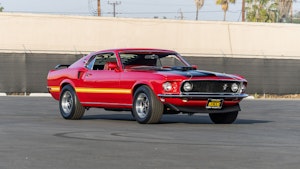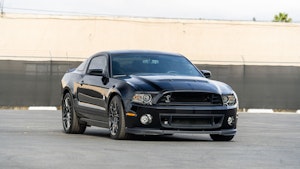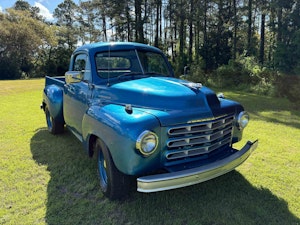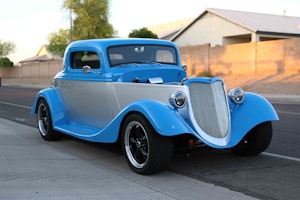Media | Articles
The Edsel: Doomed from the Start?
When we hear the word “Edsel”, we automatically think “failure”. However, if we look closely, we find that the Edsel really was a fine automobile that was on the very cutting edge of automotive design and styling. Was it the styling cue known to the public as the “horse collar” front end that doomed the new car, or was it simply a matter of timing as the U.S. economy took a nosedive in 1958? Whatever the reason, there are more than a few collectors who swear by the reliability, comfort, and performance of a car so different, it dared to defy the status quo.
Many have speculated that the Edsel’s troubles started before it was born. After all, it was built at Ford’s Oakwood Boulevard facility that previously housed the assembly line for the Continental Mark II. The Continental was William Clay Ford’s foray into the world of expensive glamour. Bolted together with aircraft quality bolts and delivered to dealers under a special cover that featured a felt fleece inner liner, the Continental was America’s most expensive production car during its brief tenure with reality.
At $10,000 each, only 3,000 Americans chose to fork over the necessary funds to put one in their driveway. When the Continental Mark II was dropped on May 8, 1957, the door was open for a new assembly line at the Oakwood Plant, and along came the Edsel.
When Ford introduced the new Edsel, it did so with remarkable fanfare. Ford also went out of their way to emphasize that the Edsel was a division unto itself. Technically, it was not a model offered within the Ford lineup and the Edsel was even given its own management team, much like today’s relationship between Saturn and GM.
Publicity began flooding newsprint and film in the opening months of 1957 in order to create excitement over the new Edsel. On January 21, 1957, Edsel Division General Manager R.E. Krafve was quoted as saying, “The new Edsel line of cars will surpass the originally announced first-year sales goal of 200,000 units.” It was indeed an optimistic statement as total production for the Edsel’s three-year tenure totaled only 110,847 units.
Marketplace
Buy and sell classics with confidence
Upon its introduction to showrooms in late 1957, the Edsel was well received at first. In fact, the Edsel set an all-time record for deliveries of a brand new medium-priced automobile, but it was downhill from there. The recession of 1958 caused Americans to keep most of their dollars in their pockets, and the Edsels stayed on showroom floors.
Inventories on dealer lots built up and the first sign of trouble came when the Edsel brand name was melted into the Mercury and Lincoln line in late 1958. By 1959, it was painfully obvious that the Edsel had an identity problem. Automotive historians have pondered the Edsel’s lineage and how it would have faired had it been offered as a new Ford model instead of trying to tread the rough waters on its own? Sadly, that answer will never be known as the Edsel was discontinued on November 19, 1959 with a mere 190 units leaving the assembly line in the last month. It was a dismal end for a car that had held such promise.
The Edsel featured here is certainly a special one indeed, as it could very well be the lowest mileage Edsel in existence. It is not restored, it has not been repainted, and has had little more than regular oil changes since it was built in 1958. Owner Nick Pagani bought the Edsel after servicing it at his repair shop for a local gentleman for a number of years. The Edsel was originally purchased new by a doctor, who used it sparingly for only two years when he passed away in 1960.
The car had not accumulated very many miles when it was sold to its second owner, who used it in a very strange way. It seems that he would start the Edsel every morning, and drive the car down to his mailbox for the morning paper. He then put the car in reverse and backed it up the driveway and into the garage to await the next day’s outing. During this time he never even registered the car, and this went on for 25 years with the Edsel leaving the yard only for service.
The Edsel was then sold to a collector with only 2,200 miles on it, and Pagani purchased the Edsel in 1999 with 4,800 miles. It’s a strange story indeed, but no one can dispute the fact that this particular 1958 Edsel Citation is one of the finest originals in existence. Pagani admits to being hesitant about adding miles to this gem, but he does drive it occasionally, where it always gets its fair share of smiles.
He also trailered it to the 2000 Burn Prevention Concours in Bethlehem, Pennsylvania where it placed first as “Best Original Postwar Car.”The Edsel also received its Junior Award at the AACA Hershey Show in 2000, and what’s amazing is that it was competing against many perfectly restored cars!According to Pagani, “Over four decades later, it still drives like a new car.”At the present time, its odometer reads 5,900 miles.
The Edsel keeps company with over 70 other cars in Pagini’s collection, which he maintains primarily to supply Hollywood movie sets with cars shot on-location in New York City. A Beautiful Mind, Catch Me if You Can, Riding in Cars with Boys, and Mona Lisa Smile, are just a few of the movies that feature Pagani’s cars. “Occasionally, I have to find a car for them to drive off a bridge, but that’s not going to happen to my Edsel!”
The Edsel was a car that America either loved or hated, and according to the history books, most hated it. In reality, it was no different than any other new model, but it was doomed from the start by a motoring public that saw it as an attack on the status quo in a recession year. While it may be gone and its history recorded long ago, the Edsel is loved by many who see it as a truly unique collector automobile. Long live the Edsel!
Dennis David is an automotive journalist living in the beautiful woods of Northwestern Connecticut. He has been a collector of antique automobiles for over twenty-five years. His current collection features a 1948 DeSoto, a 1959 Buick LeSabre, and a 1950 Willys Overland Jeepster. His love for the automobile started with a 1963 Mercury Comet, and he has since owned over thirty collector cars and trucks. He is a member of the prestigious Society of Automotive Historians and serves as the Technical Editor for the National DeSoto Club. His work can be read on the pages of many magazines, and he has authored several books.









